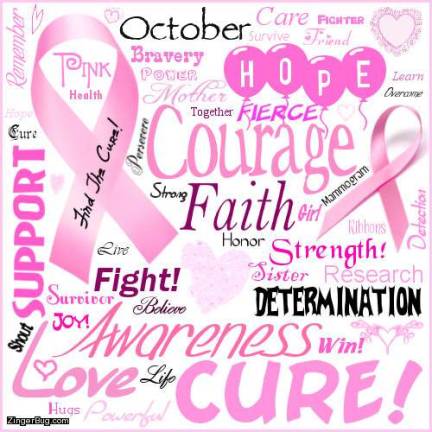October is Breast Cancer Awareness Month

Fall colors will soon be abundant - the beautiful yellows, reds and oranges of the trees.
But it's October, and pink is the color of the month.
October is Breast Cancer Awareness Month, an annual international health campaign organized by major breast cancer charities every October to increase awareness of the disease and to raise funds for research into its cause, prevention, diagnosis, treatment and cure. The campaign also offers information and support to those affected by breast cancer.
Breast Cancer is the most common cancer diagnosed in women in the United States, other than skin cancer. It is the second leading cause of cancer death in women, after lung cancer.
The chance of a woman having invasive breast cancer some time during her life is about 1 in 8. The chance of dying from breast cancer is about 1 in 37. Breast cancer death rates have been going down. This is probably the result of finding the cancer earlier and better treatment. Right now there are more than 3.1 million breast cancer survivors in the United States.
When breast cancer is found early, it can be easier to treat. If you are 40 or older, talk to your doctor about the screening plan that’s best for you and report any breast changes right away.
Breast cancer screening means checking a woman’s breasts for cancer before she has any symptoms. A mammogram is an X-ray picture of the breast. Mammograms are the best way to find breast cancer early, when it is easier to treat and before it is big enough to feel or cause symptoms.
Most women who are 50 to 74 years old should have a screening mammogram every two years. If you are 40 to 49 years old, or think you may have a higher risk of breast cancer, ask your doctor when to have a screening mammogram.
Some things may increase your risk
The main factors that influence your breast cancer risk are being a woman and getting older. Other risk factors include:Changes in breast cancer-related genes (BRCA1 or BRCA2).
Having your first menstrual period before age 12.
Never giving birth, or being older when your first child is born.
Starting menopause after age 55.
Taking hormones to replace missing estrogen and progesterone in menopause for more than five years.
Taking oral contraceptives (birth control pills).
A personal history of breast cancer, dense breasts, or some other breast problems.
A family history of breast cancer (parent, sibling, or child).
Getting radiation therapy to the breast or chest.
Being overweight, especially after menopause.
Breast cancer symptoms
Other conditions can cause the symptoms listed below. If you have any signs that worry you, call your doctor.Some warning signs of breast cancer are:
New lump in the breast or underarm (armpit).
Thickening or swelling of part of the breast.
Irritation or dimpling of breast skin.
Redness or flaky skin in the nipple area or the breast.
Pulling in of the nipple or pain in the nipple area.
Nipple discharge other than breast milk, including blood.
Any change in the size or the shape of the breast.
Pain in the breast.
Can’t afford a mammogram?
If you have a low income or do not have insurance and are between the ages of 40 and 64, you may qualify for a free or low-cost mammogram through the Centers for Disease Control's National Breast and Cervical Cancer Early Detection Program. Call 800-CDC-INFO.For more information about breast cancer, go to www.cdc.gov/cancer/breast/ or call 800-CDC-INFO (800-232-4636), or go to www.makingstrides.acsevents.org.
Sources: www.cdc.gov, www.makingstrides.acsevents.org.